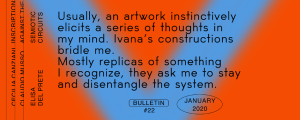Adrián Villar Rojas, Today We Reboot The Planet, Serpentine Sackler Gallery

Adrián Villar Rojas. Installation view, Today We Reboot The Planet, Serpentine Sackler Gallery, London. © 2013 Jörg Baumann
The inaugural exhibition at the newly launched Serpentine Sackler Gallery had much to live up to. Its elder sibling, The Serpentine Gallery, is a major destination for contemporary art and culture, having so well exploited both the galleries’ shared characteristics of a quirky building and location.
Today We Reboot The Planet, the first UK exhibition by Argentinian artist Adrián Villar Rojas, did not disappoint. Rojas, who represented Argentina in the 54th Venice Biennale in 2011 and participated in dOCUMENTA (13) last year, is best known for his monumental sculptures. His works encompass the notion of ‘multiverses,’ parallel worlds of destruction and loss, such as his leviathan clay whale placed in a forest in Argentina and entitled My Dead Family in 2009.
Rojas’ installation for the Serpentine Sackler Gallery is a kind of apocalyptic mausoleum, and revisits these concepts, which are further embellished by responding to the specifics of the new gallery, a former ammunitions store built in 1805 under the threat of Napoleonic invasion. It is somewhat fitting that the original building – The Magazine – once the storehouse of gunpowder, an agent of destruction, has found new life temporarily housing Rojas’ installation of annihilation and nascent beginnings.
Entering the building, I almost collide with a large clay elephant straining to maintain the load of a large, cracked concrete panel, before negotiating the formidable columns surrounding the inner vault. The interior, approached from the side, is lined with three long rows of industrial shelves containing what appears to be a dizzying assortment of artefacts – a kind of faux archaeological archive. The multifarious sculptures, viewed as a cacophony of grey clay also include wood, steel, concrete and found objects: a clay Kurt Cobain, splintered and deteriorating is supported with water bottles; the clay legs of Michelangelo’s David stand witness to a couple of nuzzling kittens; real bread is sandwiched between two concrete slabs; clay corn on the cob complete with intricately made kernals look almost appetising; and real potatoes sprouting shoots, are all part of an apparently haphazard order of objects. Here, the real and constructed appear interchangeable: I notice a loaf of bread, one half made of yeast and flour, the other made of clay. Which half, I find myself wondering, is real, and which half is in the act of becoming the other?

Adrián Villar Rojas. Installation view, Today We Reboot The Planet, Serpentine Sackler Gallery, London. © 2013 Jörg Baumann

Adrián Villar Rojas. Installation view, Today We Reboot The Planet, Serpentine Sackler Gallery, London. © 2013 Jörg Baumann
Rojas works mostly with clay, one of the oldest art materials in the world, made literally of earth. By keeping his objects unfired, they are imbued with an ashy, grey patina reminiscent of the well-preserved artefacts and victims from another destroyed civilization, Pompeii. Additionally, being unfired they are also extremely fragile, literally disintegrating and decaying before us.
Interspersed throughout, either embedded in or adjacent to the works, are green shoots, sprouting somewhat precariously, determined to pursue life amongst the disintegration. Artists like Mark Dion and Claire Pentecost have both employed soil or plant ecosystems in their practices to explore knowledge systems or alternative value systems; Rojas, by placing it amongst his fragmenting clay and found objects, juxtaposes a persevering, fragile life with inevitable death.
One aspect that permeates Rojas’ work is failure, and once again it resurfaces here with his fragmenting, decaying sculptures. Yet, surveying Rojas’ inventory of objects, each sculpture contains its own narrative, a world within a world: the bizarre, the comic, the melancholic, and the ironic. They reflect Rojas’ eclectic choice of references from the Big Bang Theory, song lyrics, philosophy and comics amongst other. The sheer volume of the objects and their intricate nature suggestive of extensive physical labour are a testament to the large team with whom Rojas works. Rojas has spoken of his role as being akin to a director of a film production, working in a collaborative, organic process.
Contemporary art, with its open-ended, decentred approach and multiple meanings often leads one to embrace two opposing ends of an idea or a dialectical argument. Standing amidst Rojas’ installation, I can’t help but think of it as a kind of time capsule, and that somehow I’ve been catapulted into the future and I’m now looking back at the present as the past.
This notion of the past and the future, or a synthesis of the old and the new, has been carried through to the design concept of new gallery itself. Adjacent to the converted classical brick structure of the original building, a magnificent futuristic tensile structure, resembling the delicate undulations of a shell has been designed by Zaha Hadid architects.
The Serpentine Sackler Gallery will hold exhibitions that will resonate with its sister gallery, which has concurrently launched a retrospective exhibition by Italian artist Marisa Merz – recently awarded the lifetime achievement award at this year’s Venice Biennale. Merz’s work in the exhibition spans her 50 year career, a counterpoint to the younger Rojas, who by comparison has recently emerged on the international circuit. There are, however, connections between the two artists’ practices – their works posses a sense of fragility, often occupy the space between abstraction and figuration, and are made of natural materials such as clay – and Rojas’ installation resonates well with Merz’s multimedia works. It will be interesting to see how the programme at the new Gallery unfolds and correlates with that of its successful elder sibling, but for now Rojas’ exhibition at the Serpentine Sackler Gallery has made a stunning start.
Adrián Villar Rojas, Today We Reboot the Planet. Serpentine Gallery, London through 11 November 2013
by Gowri Balasegaram
in Focus on Europe
Oct 1, 2013
























